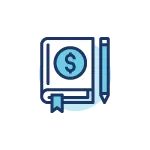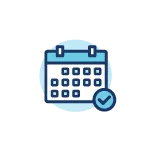Instead of setting aside cash each month and hoping to have enough saved when you actually need it, here are 9 ways to create real saving goals in 2024.
9 Ways to Create Better Savings Goals
The standard for a healthy emergency fund is to have enough cash set aside to cover between three and six-months' worth of basic expenses.
- Determine what to save for.
- Start with the amount you want to save for.
- Create a timeline.
- Budget for it.
- Create individual savings funds.
- Choose where to save.
- Automate your savings.
- Have an Emergency Fund Plan.
- Reassess your savings priorities.
1. Determine what to save for.
One of the biggest mistakes people make when setting aside money for savings is not knowing exactly what they're saving for.
When you begin saving money without a plan, you'll end up with a savings account full of cash, but no purpose.
When this happens, some of that money may be for emergencies, a portion could be for a vacation, and the rest may end up falling back into your checking account to buy more “stuff.”
This time around, define exactly what it is you're saving for - an emergency fund, a down payment for a house, a new car, upcoming vacation, etc.
Regardless of what you're saving up for, always know exactly what your savings will be used for.
2. Start with the amount you want to save.
Determine the amount you need to save when it comes time to tap into your savings. This may seem obvious, but it's often overlooked.
Let's say you have an upcoming vacation this summer and you want to save all the money you need before you go. Break down the exact dollar amount you need before the vacation starts.
Think about how much it will cost to travel to your destination and then determine how much you'll need for food, drinks, spending cash, souvenirs, or any other expenses.
When you take the time to determine exactly how much you need to save, you go from saving what you think you need to knowing exactly what your savings goal is.
3. Create a timeline.
After identifying what you're saving for and the exact amount you need, it's time to create your timeline for funding that savings goal.
The good news is there isn't a right or wrong frequency for saving. For example, you can choose to save monthly, bi-weekly, weekly, or even daily.
The process is simple — just take your savings goal amount and then divide it by the amount of time you have until you need it.
For example, if you're saving $2,500 for a vacation that is six months away, then you could save in any of the following ways:
- $417 per month
- $209 every two weeks
- $105 every week
- $14 per day
5. Create individual savings funds.
For every savings goal you have, create an individual savings account. Also known as sinking funds, these savings accounts can be nicknamed to what you’re saving for.
For example:
- Savings account #1: Emergency Fund
- Savings account #2: Vacation Fund
- Savings account #3: Christmas Fund
Instead of saving for multiple things in one savings account, it’s best to have an account for each item you’re saving for. This also helps to check on your savings progress by simply looking at the account balance for each savings fund.
7. Automate your savings.
The best way to build strong savings habits is to automate it.
A study by Carnegie Mellon found that when people spend money, the brain senses pain. The study goes on to say that when people spend with cash and actually see the money transferring from their hand to someone else, the pain receptors inside the brain are activated.
On the other hand, the study also found that when using a credit card versus cash, the pain receptors are no longer activated since you don't necessarily feel the money leaving your hands.
This same principle applies to saving money.
Instead of manually saving money each month, week, or day — automate it.
This will help take away the temptation of spending your money on something else instead of transferring it into savings.
8. Have an Emergency Fund Plan.
As you've probably noticed, life doesn't always go exactly as planned. When this happens, you need to have an Emergency Fund plan ready to go.
oo often savings goals are completely thrown to the wayside because of a financial hiccup. For example, maybe you’re saving for a down payment for your future home and everything is going just the way you planned it.
But then your car starts making a funny noise and the next day you’re writing a check for a few thousand dollars to cover the expense.
To make things worse, the money to cover the car expense just came out of your down payment fund.
Ouch!
When this happens, you need to readjust the plans for your savings goals. Look at how much is left over in your savings account and then determine how much longer you have to save.
For example, let’s say your previous savings goal was $150 every week, but the car repair took a large chunk from your savings account. After you look at how much you’ll need to make up from the repair and then how much time you have left, you see that your new savings goal is $225 per week.
When this happens, it’s time to go back to your budget and get creative.
Is there something you can say “no” to right now to help you reach your savings goal on time? Or, is there something you can do to increase your income until your savings goal is reached? Can you adjust your timeline?
The key is to have a plan in place so your financial disaster feels more like a financial hiccup within your savings goals.
9. Reassess your savings priorities.
Once you’ve created a savings goal for the first item on your list, it’s time to start on your next savings goal.
Another option to consider is to rank your savings goals in order of most importance to least importance. This way when life happens and gets in the way of your savings, you can identify which goal is most important and which one can be put on pause.
For example, let's assume you're saving for a down payment for a mortgage, a vacation, and a new car.
Take a look at each one and determine which savings account must get funded ASAP versus which one could be put on pause.
In this scenario, let's assume you want to go on a vacation, you want a newer car, but you need a down payment for your future mortgage because your current lease will end a year from now.
When this happens, your down payment fund moves to the top of your list.
Savings Goals – Frequently Asked Questions
Still have questions? Here are some of the most common questions when it comes to setting up your savings goals.
-
What should I save for first?
- The number one thing that will keep you from the ability to save money is a financial emergency. And, if you don’t have any money set aside for emergencies, then every little financial hiccup feels like a financial emergency. That’s why prioritizing an emergency fund is the best way to start saving money.
Save up your starter emergency fund of between $500 and $2,000 as quickly as possible. Then over time, finish your fully funded emergency fund of three to six months’ worth of emergency expenses. -
Should I save into a savings account or something else?
- This all has to do with how long you have before you will access your savings — and sometimes you won’t know exactly how long.
For example, your emergency fund is savings you actually hope to never use, but you also need to have access to it in a moment’s notice. Therefore, a savings account would be the ideal place to store your savings.
On the other hand, if you’ve established some savings and know you won’t need to touch that money for a few months or years, then a share certificate from a credit union could be a better option. With a share certificate, you get a much higher savings rate by committing to leave your money in the credit union for a set amount of time. -
What about retirement savings?
- Think of retirement savings as long-term savings and the savings goals we talked about above as short-term savings goals.
When saving for retirement, it’s always best to automate your retirement savings. If possible, have your retirement savings automatically deducted from your paycheck (401k, 457, 403b, TSP) each month so it never hits your checking account.
Then, build a savings plan around the money you actually receive when your paycheck hits your checking account.
If saving outside of an employer-sponsored retirement plan, it’s best to create automatic transfers from your checking account into your retirement accounts on paydays.
When income from your paycheck hits your checking account and then immediately transfers to your retirement plan, your retirement plan starts behaving similar to an employer-sponsored retirement plan.
The United States has one of the lowest savings rates compared to other countries. To put things into perspective, South Korea has a personal savings rate of 34%, Sweden at 20%, France at 15% and the United States at only 3%!
While there may be many reasons for the low savings rate, a big one is not having a plan for actually saving money.
When you put these nine savings goals into practice, you’ll go from wanting to save money, to believing you can save money, and then to actually watching your savings grow.
Chris “Peach” Petrie is the founder of Money Peach. Money Peach partnered with OneAZ to provide free financial education to members across the state. To learn more about OneAZ’s partnership with Money Peach, click here.
APR = Annual Percentage Rate





